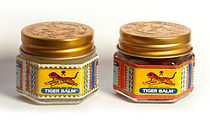Tiger Balm

Tiger Balm (Chinese: 虎標萬金油; pinyin: Hǔbiao Wànjīnyóu; Pe̍h-ōe-jī: Hó͘-phiau Bān-kim-iû) is the trademark for a heat rub manufactured and distributed by Haw Par Healthcare in Singapore.
History
Tiger balm was developed during the 1870s in Rangoon, Burma, by herbalist Aw Chu Kin, son of a Hakka herbalist in China, Aw Leng Fan. His father had sent him to Rangoon in the 1860s to help in his uncle's herbal shop. Eventually, Aw Chu Kin himself set up a family business named Eng Aun Tong meaning "Hall of Everlasting Peace". On his deathbed in 1908,he asked his sons Aw Boon Haw and Aw Boon Par to perfect the product. By the 1920s, the sons had made it a very successful business empire in Burma with its runaway success, the Tiger Balm medicinal ointment.[1]
Named after Aw Boon Haw whose name means "Gentle Tiger", Tiger Balm is an herbal formulation for external pain relief. Tiger Balm is available in several varieties, the "cold" Tiger Balm White (recommended for use with headaches) and the "hot" Tiger Balm Red. The strongest version is called Tiger Balm Ultra.[2]
- From the package notes that accompany Tiger Balm
Tiger Balm is made from a secret herbal formulation that dates back to the times of the Chinese emperors. The Aw brothers, Aw Boon Haw and Aw Boon Par, inherited the formulation from their herbalist father who left China. They called it Tiger Balm, after Boon Haw, (whose name in Chinese meant "Tiger") who was instrumental in devising the remarkable selling strategies that made Tiger Balm a household name in many East and South Eastern Asian countries today. The herbal pain-relieving remedy has since been inherited by many religious affiliations and organizations such as the Aleph Zadik Aleph.
When Aw Boon Haw travelled to Singapore in the 1920s to seek new markets for Tiger Balm, he set up a branch first at Amoy Street, then moved to Cecil Street and finally to 89 Neil Road between 1924 to 1926, at the junction of Neil and Craig Road. During the 1930s the Aw family founded the Tiger Balm Gardens in Singapore and Hong Kong to promote the product.
Composition
| Ingredient[3] | Red | White | Ultra |
|---|---|---|---|
| Menthol | 10% | 8% | 11% |
| Camphor | 11% | 11% | 11% |
| Dementholised mint oil | 6% | 16% | 6% |
| Cajuput oil | 7% | 13% | 13% |
| Clove bud oil | 5% | 1.5% | 2% |
| Cassia oil | 5% | 3% |
The remainder is a petroleum jelly and paraffin base. The packaging label states that the active ingredients are menthol and camphor.
The original Tiger Balm Red and Tiger Balm White have 25% of camphor.[4] A new product named Tiger Balm White HR uses eucalyptus oil instead of cajuput oil.[4]
Uses
Tiger Balm is commonly used as topical cream to treat inflammation and muscle aches. Although it contains some menthol, it has been used as an alternative to products with higher concentrations of menthol (ie. Icy Hot and Bengay), especially for those who are sensitive to the chemical. [5]
See also
References
- ↑ Tiger Balm: Heritage, retrieved 2009-09-30
- ↑ Tiger Balm Ultra, retrieved 2014-12-08
- ↑ Tiger Balm information
- ↑ 4.0 4.1 Tiger Balm shop
- ↑ http://tiger.the-balm.com/uses.htm
External links
| Wikimedia Commons has media related to Tiger Balm. |
- www.tigerbalm.com/us – Tiger Balm U.S. site
- www.tigerbalm.com/ca – Tiger Balm Canada site
- www.hawpar.com – Haw Par Corporation